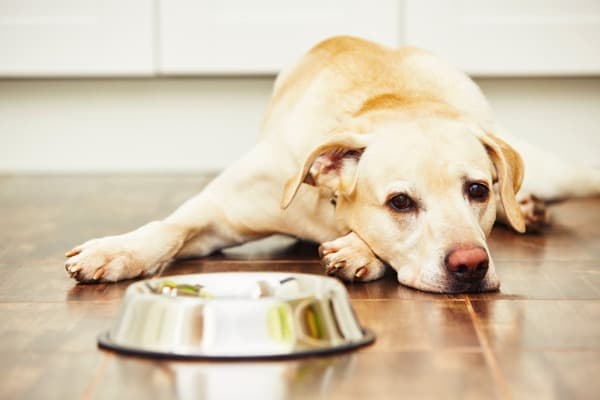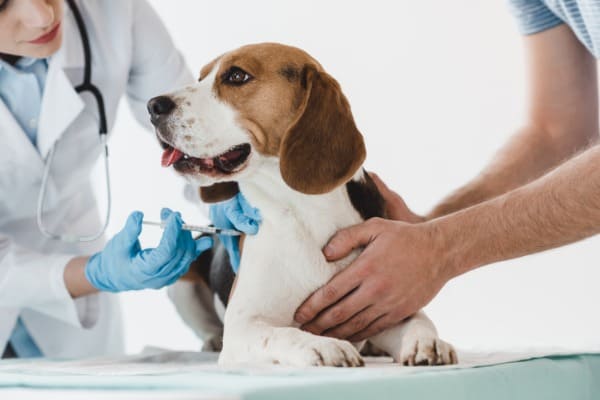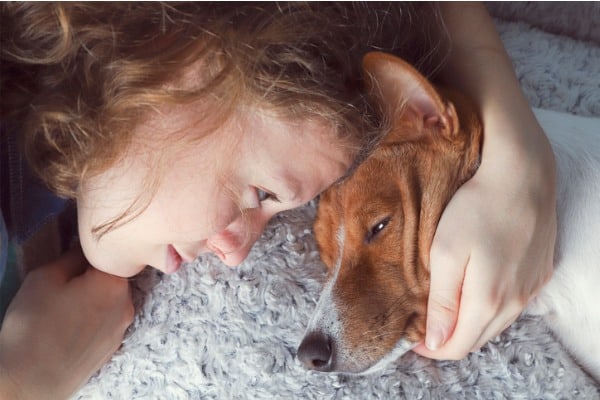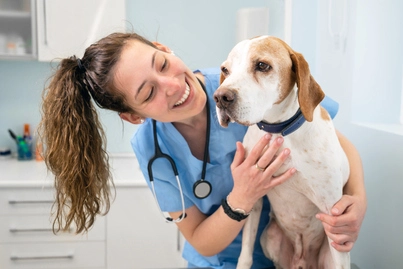It’s alarming when your usually vibrant best friend does a 180, and their energy seems to drain.
Whether your dog is picky or a healthy eater, abruptly refusing food and water is even more cause for concern.

You might feel stressed, upset, and helpless – but dogs rarely show symptoms without there being a specific cause.
So what can you do?
Your dog can’t tell you what’s bothering them, but you can help figure out what’s caused their change in behavior.
And fear not: you’re not on your own.
Contact a Vet
Sometimes, your vet is the one who can narrow down exactly what’s going on if your dog won’t eat or drink and just lays there.
Vet trips are expensive and stressful for you and your dog.
If you’re immediately concerned with any of the symptoms or complications related to your dog’s condition, you can have a quick chat with a vet online now, which is both a cost and time savings.
Connect with a verified veterinarian in minutes. No waiting for appointments or office hours. No high fees. Your pet's health made convenient and worry-free.
If you find yourself worrying: “My dog is lethargic and won’t eat or drink,” there are some questions you should ask before you panic.
We’ll help you understand the common causes of lethargy and loss of appetite and when you should contact a vet to address your dog’s health.
Physical Reasons Your Dog Has Stopped Eating and Drinking

Dogs are not so different from us – illnesses can also make them lose their appetites.
In dogs, refusal to eat is referred to as anorexia, although it’s not purely a psychological disease like in humans.
Sometimes, a lack of appetite and energy is the first indicator of certain illnesses.
There are other symptoms to look out for when your dog has a sudden change in eating habits and energy levels.
Infections: Take Them Seriously
If you suspect your dog has one of the following infections, get them medical treatment immediately.
Parvovirus
This is seen most often in puppies and is very dangerous for them.
The kicker here: puppies need three rounds of parvo vaccines at 6, 8, and 12 weeks, but they aren’t completely protected until they get the entire series.
So let’s say you brought your puppy home at 8 weeks – they could be susceptible to parvo until they’re 12 weeks old.
Parvo is notoriously contagious, and not all pet owners are responsible for reducing its spread.
Prevention is essential here – if you live in an area such as an apartment complex, it’s hard to limit your puppy’s exposure to the virus, short of keeping them indoors until they’re fully vaccinated.
Parvo is so contagious that most vets will recommend you don’t set your puppy down on the floor of the vet’s office.
So if your puppy isn’t fully vaccinated and could have been exposed to parvo, they need veterinary treatment immediately if they seem lethargic.
Refusing to eat and drink could also be an early disease symptom.
Your puppy might also be running a fever and have strong-smelling diarrhea.
Please note that once puppies show parvo symptoms, they can die in as little as 48 hours if they don’t receive medical attention.
This is a situation where time is of the essence – if you suspect parvo, err on the side of caution and get to a vet as soon as possible. It could save your puppy’s life.
Distemper
This virus attacks the intestinal, respiratory, and nervous symptoms in dogs.
Because it affects the intestines and stomach, refusal to eat and drink can be an early symptom.
If your dog isn’t eating and displaying watery, runny eyes and nose, it could very well be a sign of distemper. They can also have a cough, diarrhea, and vomiting.
It is essential to get your dog checked out if they show these symptoms; left untreated, distemper is fatal.
The good news is it’s easily preventable: distemper vaccines can be given as early as 6 weeks old, and the virus doesn’t last in the environment as long as parvo does.
Kennel Cough

All unvaccinated dogs are at risk for kennel cough or bordetella, regardless of age.
It’s part of core puppy vaccinations so that they can be protected as early as 6 weeks of age.
The tell-tale sign of kennel cough is, well, a cough. It might be loud or have a distinct “honking” sound.
Most dogs with kennel cough will also lose their appetite and seem lethargic.
While kennel cough is rarely fatal, the symptoms can be uncomfortable and painful to your dog – so you should still seek treatment if you suspect they’ve caught it.
Leptospirosis
This is another one you shouldn’t have to worry about as long as your dog is vaccinated against it – but if they’re not, you could catch it from them.
Aside from lethargy and disinterest in food, look out for increased thirst, jaundice, and shivering.
Dogs can be exposed to the bacteria in water, soil, or as a result of direct contact with the waste of an infected animal.
Some dogs have mild infections that clear on their own, but it can also be life-threatening.
“Lepto” is a zoonotic bacterial disease, so if your dog is diagnosed with it, you should take precautions from being infected yourself.
While your dog is receiving antibiotics, take extra care not to come into contact with their urine. Lepto in humans is just as miserable as it is for dogs.
An Ounce of Prevention is Worth a Pound of Cure

All of these infections are preventable in healthy dogs. Keeping your dog up-to-date on their vaccinations will not only keep them safe; it will give you peace of mind.
While some of these infections can be quite serious, they are all treatable. In most cases, the earlier they are caught, the better the prognosis.
Lethargy and anorexia aren’t always serious, but if your dog is displaying other symptoms, you should take it seriously.
Similar symptoms in puppies and unvaccinated dogs should be addressed promptly so that these infections can be tested for.
Connect with a verified veterinarian in minutes. No waiting for appointments or office hours. No high fees. Your pet's health made convenient and worry-free.
It Could be Something on Their Mind
We just covered some scary stuff – causes for your dog’s lethargy might not have such a frightening cause.
The truth is, healthy, vaccinated dogs probably won’t ever have any of the abovementioned issues.
There can be much less severe (although equally frustrating) reasons behind your dog’s lethargic state.
Dogs may not have the complex range of emotions that people do, but they can still be affected by things on a psychological level.
So, let’s ditch the frightening medical jargon for now and explore some other reasons dogs refuse to eat and lose their pep.
They’re Depressed
We still have yet to uncover many mysteries surrounding depression in humans, and we know even less about depression in dogs. But that doesn’t mean a depressed dog is beyond our help.
The fact that dogs’ emotions are less complex than ours means that making them feel better is easier.
Dogs could be depressed simply because they’re under-exercised or they’re feeling lonely.
If your dog is experiencing lower energy levels and decreased appetite, you can try taking them out (unless they refuse to walk) or playing with them.
How your dog responds to playtime or exercise can be a helpful clue.
If they perk up when you bust out the toys or leash, then your answer could lie in spending more time with them.
Luckily, trying to break them out of a funk by playing with them doesn’t mean a trip to the vet. If they resist exercise, it could be a health issue.
They’re Grieving

Dogs can indeed experience a sense of loss when a packmate or a human housemate passes or moves away.
Grief in dogs can mimic that of humans; they will lose interest in their favorite thing, refuse food, and sleep more.
A dog might also seek out things associated with the missing loved one – bedding, toys, and clothes, for example. They could also look for more attention than they normally would.
Sometimes their housemate is only gone temporarily, but sadly, some losses are more permanent.
Dogs can’t be forced into “snapping out of it” any more than a human could – in this case, time is the best thing to help heal your dog.
If you have a member of the family who leaves for extended periods – deployed servicemen and women or college students – your dog might become glum each time they leave.
Giving them things that smell like the absent person or pet can help ease their pain.
Blankets and clothing are good “gifts” for dogs who are missing someone.
It’s SAD
Your dog might seem sad because they have SAD – Seasonal Affective Disorder.
During the winter months, your dog will likely get less sunlight and outdoor time.
The decrease in exercise itself can be enough to put your pup in a mood.
But less sunlight will increase melatonin production in their body, which could make them sluggish.
Even if it’s cold outside, your dog still needs proper exercise and stimulation.
Winter is a great time to take advantage of inside games and mentally stimulating activities.
If the weather is just too bitter for more than a thirty-minute walk, make time to play indoors, and consider puzzle-type toys to keep your dog entertained.
They’ve Been Subjected to Improper Training Methods

Punitive training is ineffective and causes many more problems than it solves.
The Golden Rule of dog training is never to hit your dog.
Even a rolled-up newspaper can be enough to break the trust between you.
Avoid yelling or raising your voice at your dog. Instead of punishing bad behavior, reward good behavior.
Punishing dogs by striking them or yelling at them can cause them to experience “learned helplessness” – a psychological condition that causes depression.
A dog suffering from learned helplessness essentially shuts down because they feel they can’t escape negative situations no matter what they do.
Learned helplessness can look a lot like depression and come with a refusal to eat and avoiding usual activities.
Dogs can’t connect a negative behavior with punishment the way a toddler can – so scolding them for an accident that happened hours ago will only cause them distress. It doesn’t teach them anything.
To teach a dog that a behavior is unwanted, you must catch them in the act or shortly after.
Even then, spanking isn’t the answer. Redirect them to something else – if they relieved themselves indoors, redirect them outside.
If they’re chewing the remote control, replace it with an acceptable toy.
And as always, reward good behavior – praise and enticing treats are both highly effective.
If you have a rescue dog that seems depressed, consider the possibility they came from an unhappy home before you adopted them.
Abused dogs can be rehabilitated to trust humans and live a happy life. They just need your patience and a lot of love.
Their Human is Depressed
When you or a housemate is experiencing depression, your dog could be mirroring your symptoms.
If your depression keeps you in bed all day, don’t be surprised to find your dog by your side.
It’s not entirely clear exactly why they do, but there are a few theories.
Dogs can sense chemical changes in the human body and could be picking up on the very imbalances that cause your depression or anxiety: it’s one reason dogs can be trained to become excellent psychiatric service animals.
Dogs also tend to look to us for reassurance and comfort.
If they pick up on tension or sadness in your body language or even facial expressions, it can cause them distress too.
We know people can’t flip off their depression like a switch, not even for their beloved dog.
But knowing that getting help for themselves also means helping their dog can encourage them to seek treatment.
They’re a Nervous Wreck

We’ve said it already, but we’ll say it again – mental stress isn’t reserved for humans.
Dogs that are anxious and restless are known to refuse food.
They could also hide and sleep more often than usual.
There are many reasons they could be nervous, and it could be a health issue – eliminating this possibility with the help of a vet is an excellent measure to take.
Once you know your dog isn’t sick or injured, you can start deducing why they’re feeling so nervous.
Did You Recently Move?
Dogs need time to adjust to new living situations. While some approach a new environment with excitement, some will be quite distressed at first.
Try to reproduce your dog’s old sleeping arrangement as soon as possible when moving.
The same goes for their food and water.
These things will help give them a sense of normalcy and ease the transition into their new home.
Also, try to adhere to regular schedules as best you can. We know moving is time-consuming, but taking a break from unpacking for your daily walk could benefit both of you.
Are You Traveling?
Whether you go by train, plane, or automobile, traveling can throw some dogs into a tizzy.
Their routine is disrupted, their familiar smells are replaced with new, strange ones, and they might be exposed to a lot of new people and pets.
If your trip is short, it’s possible your dog will refuse food the entire time.
Most otherwise healthy dogs will eventually eat once they become hungry enough – but a two-day hunger strike isn’t unheard of.
Has There Been a Change in the Routine?
Did you recently switch from the day shift to the night shift? Or perhaps you’ve been working overtime recently.
Small shifts in a routine can throw off your dog’s mood. Dogs are creatures of habit, so alterations in their schedule might make them nervous.
If a change is inevitable, try to bring it on gradually. Instead of changing their dinnertime from 5 pm to 8 pm in one day, approach it by feeding them 15-20 minutes later over the course of a few weeks.
Sometimes we don’t have the luxury of easing into a new routine.
Asking a trusted friend, family member, or pet sitter for help can make a new schedule less of a shock for your dog.
Is There a New Addition to the House?
Whether it’s a bouncing baby Beagle, a feline bundle of joy, or a new human sibling, an extra family member can throw your dog for a loop.
A dog might express their nervousness by avoiding their favorite areas in the house, hiding, and refusing food.
Most dogs need some time to adjust to someone new. The proper introduction also lays the groundwork for a stress-free transition for all parties involved.
Be Patient With Your Dog
The psychological reasons your dog is lethargic aren’t fixed in a day. It might take time to narrow down the root issues.
Once you’ve done that, your dog needs your time and patience to get through whatever is troubling them.
Dogs who refuse food can lose weight and suffer some health issues as a result.
If your dog’s anorexia is pronounced, you might need to entice them to eat while the underlying problems are solved.
You can try tempting them with wet food or bone broth added to their kibble.
Of course, this runs the risk of spoiling your dog into only eating when those appetite enhancers are offered.
The trick is only to add small amounts of these treats to their meals and don’t take them away suddenly. Decrease them in small increments over a period of time.
Other Possible Causes of Your Dog’s Symptoms
There’s a laundry list of reasons your dog is refusing food and lying around for no apparent reason.
We’d need a whole book to cover them all, but here are a few more things to look out for.
Poison
Dogs eat things they’re not supposed to; we all know it. Sometimes they get ahold of something that can cause them harm.
Lack of appetite might be the result of ingesting something toxic.
Plants

Hopefully, you don’t have any toxic plants in reach of your dog’s mouth, but if your dog is suddenly acting strange, you’ll want to check those plants for signs your dog snacked on one.
Plants in the nightshade family are toxic to dogs and several varieties of popular houseplants.
Human Food
Grapes, raisins, dark chocolate, coffee, and alcohol are all things your dog shouldn’t ingest.
Of course, the list of human foods dogs shouldn’t eat is extensive.
Don’t forget gum – if it contains xylitol, it could be fatal to your dog. A missing pack of gum and a lethargic dog warrant an immediate trip to the vet.
Medications
Eating any kind of medication intended for people is dangerous for your dog.
They might vomit or have diarrhea, but they could also become lethargic, listless, and uninterested in food.
Most medications aren’t going to be fatal, provided you get your dog to the vet ASAP.
They might be in for a round of activated charcoal, and you’ll have an expensive lesson in keeping medications secured.
Poisonous Substances
Cleaning materials, antifreeze, and rodent poison are all as toxic to a dog as they would be to you.
Dogs might eat an animal that has been killed by poison, exposing them to the poison themselves.
Dogs like to lick and sniff things and could accidentally consume something toxic in your garage or under your sink as a result. Each of these scenarios requires a vet’s help.
Foreign Objects
If your dog decided to chow down on your cactus, their lack of appetite could have two explanations: the plant was toxic, or the spines are stuck in your dog’s gums.
Dogs won’t eat or drink if it causes pain. You can carefully inspect your dog’s mouth for sharp objects.
Dogs have been known to eat some pretty weird things – sewing needles, thumbtacks, and metal shavings can get stuck in your dog’s mouth.
If you find a foreign object, removing it yourself could cause further damage.
Let the vet take care of it, and try to find where your dog picked it up so you can prevent it from happening again.
Parasites
If your dog isn’t on a worm-prevention pill and they’re acting tired, they could be suffering from anemia.
Only severe infestations cause pronounced symptoms in most dogs, but it’s still good to rule out the possibility. Better yet, make sure your dog is on preventive medication.
Fortunately, worm infestations are easily treated – however, the aftermath isn’t for the faint of heart.
Dog-proof Your Home

Caught early enough, these toxic substances are usually treatable. Size and age dictate how a dog will react to eating something toxic and how much they ate.
But if you suspect poisoning, it’s time to load your dog up for a trip to the vet.
The best way to avoid these situations is to make sure your home is safe for your dog.
Secure all toxic plants (or give them away to pet-free households)—research before you share people food with your dog.
Keep sharp objects, medications, and poisonous substances secure and well out of reach of your pup.
Be careful of your dog snapping up food off the ground outside – there are some bad folks out there who lace such things with poison or needles.
And as far as worms go – you’ll thank yourself big time for spending extra on anti-parasite pills.
You can’t put a price on avoiding the yuck factor of your dog expelling dead worms.
Luckily, most pet owners only have to endure this once before they learn their lesson.
Speaking Dog Language
A dog who is lethargic, not eating or drinking, and just lying around is a dog trying to tell you something.
As their human, it’s up to you to try and figure out what they’re trying to say.
Are they sick? Are they sad? Are they stressed?
Some of these questions have easy answers, and some need the knowledge of a trained vet.
Either way, be in your dog’s corner.
You’re their number one advocate, and they need your help to put the spring back in their step – and the kibble back in their tummy.

